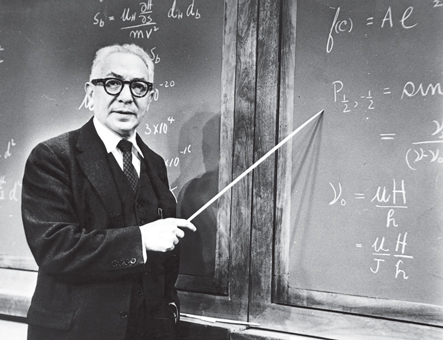Abstract
This is an introduction to the special issue collection of articles on Semi-classical and quantum Rabi models to be published in J. Phys. A: Mathematical and Theoretical to mark the 80th anniversary of the Rabi model.
Export citation and abstract BibTeX RIS
In the springtime of quantum mechanics, in 1936, Isidor I Rabi investigated the semi-classical version of a model which now bears his name [1]. The Rabi model describes the simplest interaction between a two-level atom and a classical light field. The fully quantized version was considered by Jaynes and Cummings in 1963 for the case where the rotating-wave approximation can be applied [2].
The quantum Rabi model has Hamiltonian

Here  and
and  are Pauli matrices with
are Pauli matrices with  and a the creation and destruction operators for the single bosonic mode. The light–matter interaction is controlled by the coupling parameter g, with
and a the creation and destruction operators for the single bosonic mode. The light–matter interaction is controlled by the coupling parameter g, with  the mode frequency and
the mode frequency and  the qubit frequency. Distinct dynamics for different regimes are defined by the relation among these three parameters (see figure 1).
the qubit frequency. Distinct dynamics for different regimes are defined by the relation among these three parameters (see figure 1).
Figure 1. The different coupling regimes in the configuration space of frequencies associated with the quantum Rabi model of equation (1). Regions 4 and 5 define the ultrastrong and deep strong coupling regimes, respectively, in which the Jaynes–Cummings model is not applicable. Reproduced with permission from [12], copyright 2015 Nature Publishing Group.
Download figure:
Standard image High-resolution imageThe restricted model, known as the Jaynes–Cummings model, has always shadowed the more general aspects of the quantum Rabi model. This is because the conditions for applying the rotating-wave approximation to the quantum Rabi model, which leads to the Jaynes–Cummings model, are directly relevant to most experimental regimes, where  is small.
is small.
Figure 2. Isidor Isaac Rabi (1898–1988) was awarded the Nobel Prize in Physics in 1944 for discovering nuclear magnetic resonance. His name is associated with a number of key concepts in physics, including the Rabi model which describes the interaction between a two-level atom and a light field. Photo credit: University Archives, Rare Book & Manuscript Library, Columbia University in the City of New York.
Download figure:
Standard image High-resolution imageMoreover, the Jaynes–Cummings model is easy to solve, allowing the physical properties of the model to be readily obtained and compared with a large number of experiments. The basic physics explored in the Jaynes–Cummings model alone has many remarkable facets, including Rabi oscillations, collapses and revivals of quantum state populations, quadrature squeezing, entanglement, Schrödinger cat states and photon anti-bunching [3].
However, the situation has recently changed with the quantum Rabi model stepping into the spotlight. There are three basic reasons: (i) experiments have now been able to push into the ultrastrong ( ) [4, 5] and deep strong (
) [4, 5] and deep strong ( ) [6] coupling regimes in which the rotating-wave approximation and thus the Jaynes–Cummings model are not applicable; (ii) there are exciting prospects for novel regimes of light-matter interactions [7] and potential applications in quantum information technologies [8]; (iii) an analytic solution was obtained for the full quantum Rabi model [9–11], followed by further progress on solving various extensions of it. It is noteworthy to mention that the conceptual and experimental advances call for deeper mathematical analysis, with no restrictions on the possible values of any model parameter.
) [6] coupling regimes in which the rotating-wave approximation and thus the Jaynes–Cummings model are not applicable; (ii) there are exciting prospects for novel regimes of light-matter interactions [7] and potential applications in quantum information technologies [8]; (iii) an analytic solution was obtained for the full quantum Rabi model [9–11], followed by further progress on solving various extensions of it. It is noteworthy to mention that the conceptual and experimental advances call for deeper mathematical analysis, with no restrictions on the possible values of any model parameter.
Circuit quantum electrodynamics, two-dimensional electron gases, and trapped ions, supported by the concepts of quantum metamaterials and quantum simulations [12], have emerged as platforms for faithful representations of abstract models, quite analogous to the possibilities established by the advent of cold atom physics. The impact on practical applications is even greater, because the two-level system appearing in the semi-classical and quantum Rabi models is a qubit, the building block of quantum information technologies with the ultimate goal to realize quantum simulations and quantum computations. These Rabi models thus form the connecting link in this interplay of mathematics, physics, and technology. The novel applications of certain branches of classical mathematics to quantum physics may even inspire efforts to attack hitherto unsolved problems within pure mathematics itself [13], whereas other relevant developments, e.g., the theory of quasi-exact eigenstates [14], may have direct implications for quantum information theory.
This special collection of articles is dedicated to the semi-classical and quantum Rabi models, with all their variants and possible extensions, including nontrivial multi-qubit and multi-photon scenarios. In addition to marking the 80th anniversary of the (semi-classical) Rabi model, we anticipate that this collection of articles will inspire further developments in this important area of cross-disciplinary research.


